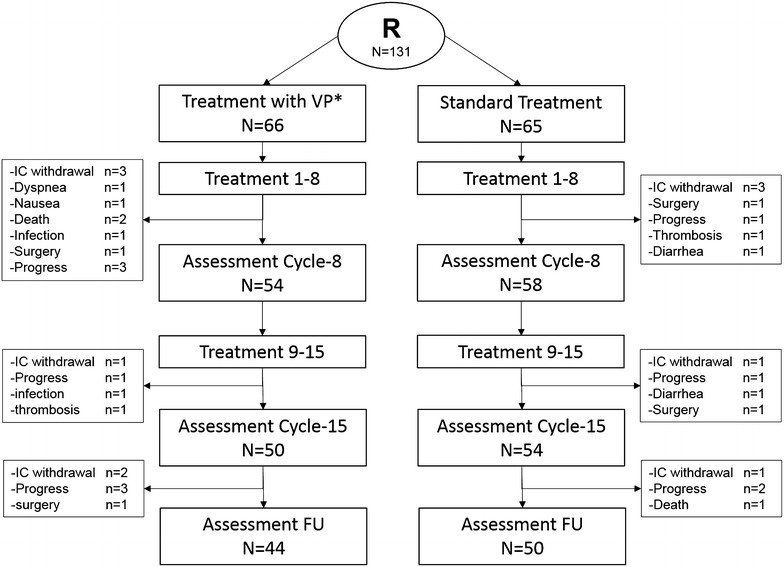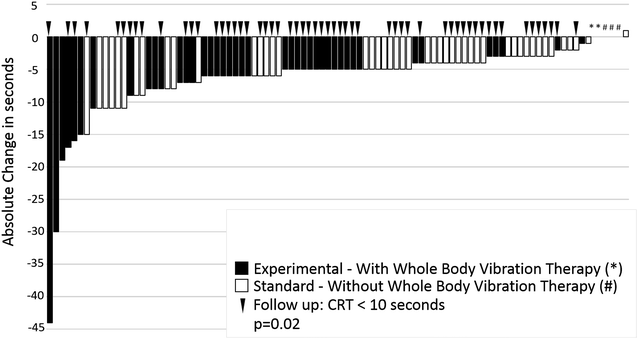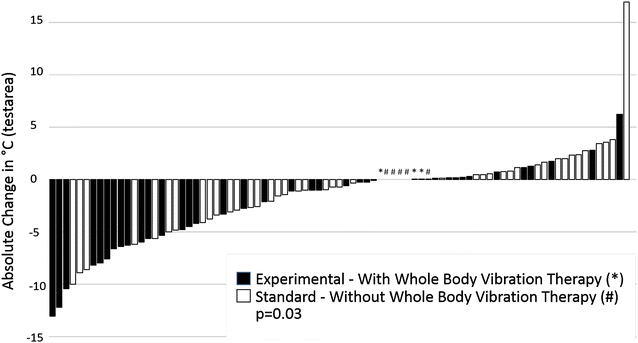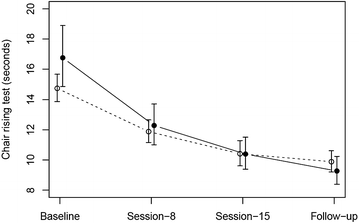A randomized exploratory phase 2 study in patients with chemotherapy-related peripheral neuropathy evaluating whole-body vibration training as adjunct to an integrated program including massage, passive mobilization and physical exercises
- PMID: 28194306
- PMCID: PMC5297221
- DOI: 10.1186/s40164-017-0065-6
A randomized exploratory phase 2 study in patients with chemotherapy-related peripheral neuropathy evaluating whole-body vibration training as adjunct to an integrated program including massage, passive mobilization and physical exercises
Abstract
Background: Chemotherapy-induced polyneuropathy (CIPN) is a common toxicity after chemotherapy, immunomodulatory drugs or proteasome inhibitors, which is difficult to treat and may also have impact on quality of life. The objective of the study was to evaluate whole-body vibration (WBV) on the background of an integrated program (IP) including massage, passive mobilization and physical exercises on CIPN.
Patients and methods: In an exploratory phase-2 study patients with CIPN (NCI CTC grade 2/3) were randomized for WBV plus IP (experimental) to IP alone (standard). 15 training sessions within 15 weeks were intended. As primary endpoint we used chair-rising test (CRT) to assess physical fitness and coordination. In addition, locomotor and neurological tests and self-assessment tools were performed.
Results: A total 131 patients with CIPN were randomized (standard, n = 65; experimental, n = 66). The median age was 60 (range 24-71) years; 44 patients had haematological neoplasms and 87 solid tumors. At baseline, all patients presented with an abnormal CRT. Fifteen (standard) and 22 (experimental) patients left the program due to progression/relapse or concomitant disease. There was no significant difference in the proportion of patients with normal CRT (<10 s) at follow up between experimental (68%) and standard (56%) (p = 0.20). All patients experienced less symptoms and pain (p < 0.001) and had improved CRT (p < 0.001) over time. WBV was significantly associated with a higher reduction of time needed for CRT (p = 0.02) and significantly improved warm-detection-threshold comparing baseline to follow-up assessment (p = 0.02).
Conclusion: Whole-body vibration on the background of an IP may improve physical fitness and coordination in patients suffering from CIPN. Trial registration Retrospectively registered at http://www.iscrtn.com (ISRCTN 51361937) and http://www.clinicaltrials.gov (NCT02846844).
Keywords: Chemotherapy associated side effects; Chemotherapy related peripheral neuropathy; Integrated training program; Whole body vibration training.
Figures




Similar articles
-
Sensorimotor training and whole-body vibration training have the potential to reduce motor and sensory symptoms of chemotherapy-induced peripheral neuropathy-a randomized controlled pilot trial.Support Care Cancer. 2019 Jul;27(7):2471-2478. doi: 10.1007/s00520-018-4531-4. Epub 2018 Oct 31. Support Care Cancer. 2019. PMID: 30382392 Clinical Trial.
-
Individually tailored whole-body vibration training to reduce symptoms of chemotherapy-induced peripheral neuropathy: study protocol of a randomised controlled trial-VANISH.BMJ Open. 2019 Apr 24;9(4):e024467. doi: 10.1136/bmjopen-2018-024467. BMJ Open. 2019. PMID: 31023750 Free PMC article.
-
Feasibility of whole body vibration during intensive chemotherapy in patients with hematological malignancies - a randomized controlled pilot study.BMC Cancer. 2018 Sep 25;18(1):920. doi: 10.1186/s12885-018-4813-8. BMC Cancer. 2018. PMID: 30253746 Free PMC article. Clinical Trial.
-
Whole-Body Vibration as a Modality for the Rehabilitation of Peripheral Neuropathies: Implications for Cancer Survivors Suffering from Chemotherapy-Induced Peripheral Neuropathy.Oncol Rev. 2015 Feb 10;9(1):263. doi: 10.4081/oncol.2015.263. eCollection 2015 Feb 10. Oncol Rev. 2015. PMID: 26779309 Free PMC article. Review.
-
Effects of whole-body vibration exercise on physical function in patients with chronic kidney disease: a systematic review and meta-analysis.BMC Nephrol. 2024 Jan 3;25(1):2. doi: 10.1186/s12882-023-03436-3. BMC Nephrol. 2024. PMID: 38172769 Free PMC article.
Cited by
-
The preventive effect of sensorimotor- and vibration exercises on the onset of Oxaliplatin- or vinca-alkaloid induced peripheral neuropathies - STOP.BMC Cancer. 2018 Jan 10;18(1):62. doi: 10.1186/s12885-017-3866-4. BMC Cancer. 2018. PMID: 29316888 Free PMC article. Clinical Trial.
-
Rehabilitation, exercise, and related non-pharmacological interventions for chemotherapy-induced peripheral neurotoxicity: Systematic review and evidence-based recommendations.Crit Rev Oncol Hematol. 2022 Mar;171:103575. doi: 10.1016/j.critrevonc.2021.103575. Epub 2021 Dec 28. Crit Rev Oncol Hematol. 2022. PMID: 34968623 Free PMC article.
-
The role of exercise on peripheral nerve regeneration: from animal model to clinical application.Heliyon. 2021 Oct 29;7(11):e08281. doi: 10.1016/j.heliyon.2021.e08281. eCollection 2021 Nov. Heliyon. 2021. PMID: 34765794 Free PMC article. Review.
-
Type of exercise may influence postural adaptations in chemotherapy-induced peripheral neuropathy.Ann Clin Transl Neurol. 2021 Aug;8(8):1680-1694. doi: 10.1002/acn3.51426. Epub 2021 Jul 18. Ann Clin Transl Neurol. 2021. PMID: 34278743 Free PMC article. Clinical Trial.
-
Non-pharmacological therapy for chemotherapy-induced peripheral neurotoxicity: a network meta-analysis of randomized controlled trials.BMC Neurol. 2023 Dec 11;23(1):433. doi: 10.1186/s12883-023-03485-z. BMC Neurol. 2023. PMID: 38082216 Free PMC article.
References
-
- Shigeno K, Naito K, Sahara N, Kobayashi M, Nakamura S, Fujisawa S, et al. Arsenic trioxide therapy in relapsed or refractory Japanese patients with acute promyelocytic leukemia: updated outcomes of the phase II study and postremission therapies. Int J Hematol. 2005;82:224–229. doi: 10.1532/IJH97.05044. - DOI - PubMed
-
- Peggs KS. Cent advances in antibody-based therapies for Hodgkin Lymphoma. Br J Haematol. 2015 - PubMed
-
- Hershman DL, Lacchetti C, Dworkin RH, Lavoie Smith EM, Bleeker J, Cavaletti G, et al. Prevention and management of chemotherapy-induced peripheral neuropathy in survivors of adult cancers: American Society of Clinical Oncology clinical practice guideline. J Clin Oncol. 2014;32:1941–1967. doi: 10.1200/JCO.2013.54.0914. - DOI - PubMed
Associated data
LinkOut - more resources
Full Text Sources
Other Literature Sources
Medical
Research Materials

